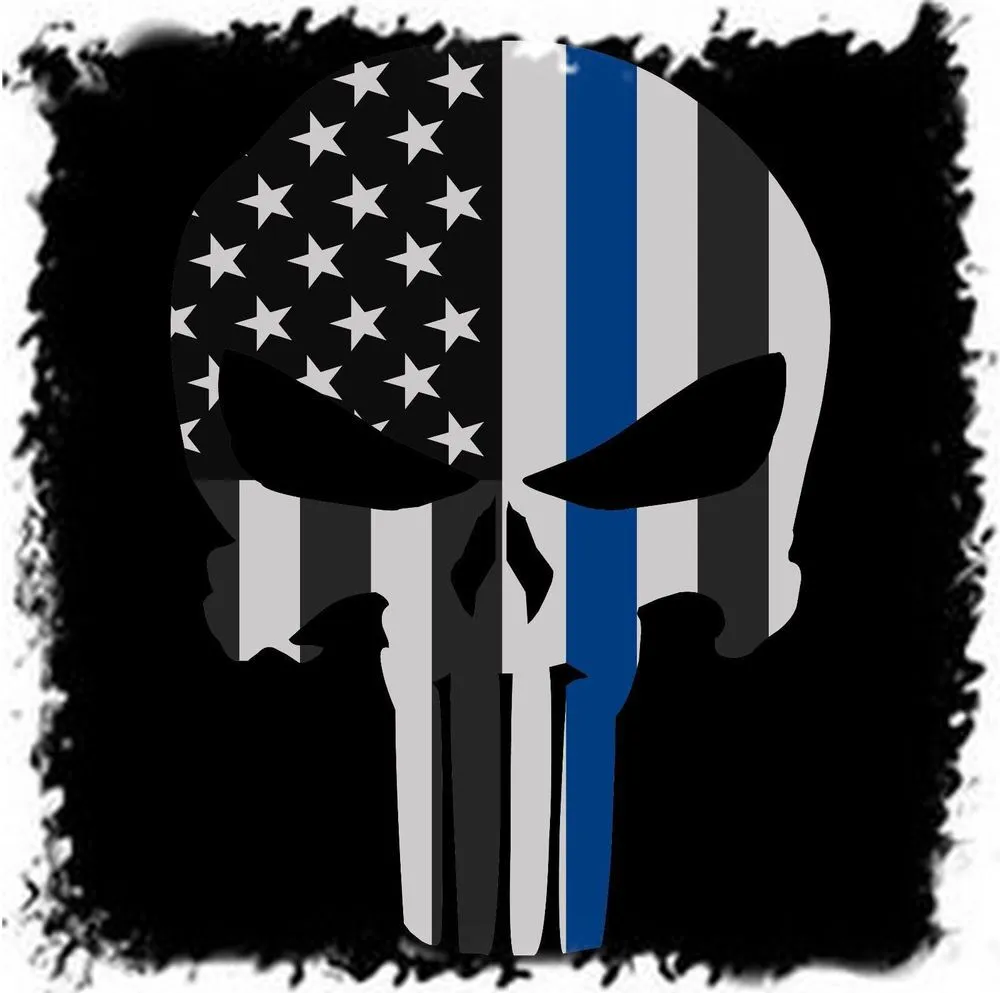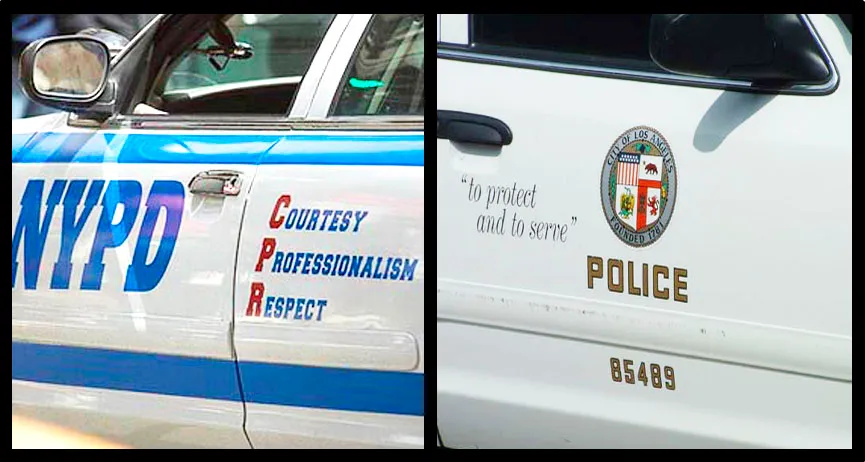
”Homo sapiens is the species that invents symbols in which to invest passion and authority, then forgets that symbols are inventions.” - Joyce Carol Oates
I started seeing this flag about two years ago and was wondering what it was. Since that time, it’s become increasingly prevalent, and you’ve no doubt seen it yourself – flying in front of homes, depicted on T-shirts and car stickers, etc. I now see it every day around my neighborhood, and I think it’s worth considering what this flag represents...
It’s called “The Thin Blue Line” flag, and it’s purported to represent support of police. The phrase which often accompanies this symbol describes police as “The thin blue line which stands between order an anarchy.”
The statement itself is partially true, though the connotation is a perversion of the truth. Police are, in fact, the primary barrier to an anarchistic society, but anarchy in this context implies chaos, lack of order, and carries nebulous notions of rampant violence and looming danger. The term anarchy actually implies nothing of the sort. The root meaning of the word is “no rulers” (just as the word monarchy means “one ruler”). And what does it mean to have no rulers? It means that you are free.
Anarchy and Order
Anarchy literally means freedom. And yes, police are the main barrier between the people and freedom, as politicians have no means by which to manifest their fallacious power without others who are willing to blindly enforce their commands. Anarchy does not imply lack of order, however, as all the world is guided by a natural order, and people may create voluntary systems of order of various kinds. In fact, they do it all the time…
Sports teams, book clubs, theater companies, businesses, charities, intimate relationships, website communities, etc., all operate under a system of voluntary order. No one is coerced by violence to participate in these communities and follow the system set forth. And yet, such organizations are successful, prosperous, and fulfilling, all over the world. Freedom does not obviate order.
Contrary to prevalent beliefs, the particular type of order (or lack thereof) has nothing to do with anarchy. Anarchy does not imply every-man-for-himself, communism, the lack of voluntary hierarchy or any such particular societal condition. It’s simply a recognition of the irrefutable truth that no individual has a rightful claim to act as an external authority over another. No one has the right to ignore your consent and make commands which you must obey under threat of punishment. There is no such thing as a valid ruler or master. Anarchy means there is no valid slavery.
A Flag of Our Own
What’s most notable about this police flag is that it presents an alternative to the American flag. Why do police have their own flag? Aren’t they supposed to be upholding the Constitution of the nation (and states) represented by the red, white, and blue version? Why are they symbolically differentiating themselves from the rest of the nation? Are they not to be included amongst “the people” in the “…of the people, by the people, and for the people” scenario?
It’s a bit disconcerting that the police force (purported to be protectors of the people, made up of the people), is beginning to adopt its own symbology. I'm reminded of the nazi Schutzstaffel (literally meaning ”protection squadron”), commonly known as the “SS”, who also had their own symbology, and who – like modern police forces – became increasingly militarized as the nation moved toward tyrannical oppression.

A red flag would be if police began employing use of "The Thin Blue Line" flag in an official capacity. As of now, they have yet to add this to their uniforms or police vehicles (to the best of my knowledge).
The Dark Symbol
And what of the specific nature of this police flag? It depicts an American flag with all the color drained out of it – black and grey (or white), save for the single blue police line. What does this desaturated aspect typically represent?
I remember watching Transformers the Movie as a child. It was notable for the fact that the main hero character, Optimus Prime, died. It was a big deal at the time. In an era without internet spoilers, many children were blindsided and traumatized. And how did the creators of the film handle the difficult-to-explain theme of death in a film targeted at young children? How did they indicate that Optimus was dead, and not merely temporarily deactivated? As the life slipped from the noble Autobot leader, all color was drained from him. His usual red, white and blue coloration was replaced with shades of grey.

Historically, dark colors like black and grey are associated with lifelessness… death. And for those who suppose this is a merely a style choice, or concoct other explanations for the decidedly dark nature of this flag, let’s take a look at the second-most common variation of this symbol – the death’s head police flag.
Protectors or Death Cult? Which is it?

This is not a unique one-off representation – it is very common and has numerous variations (some of which you can see here). I’ve seen this myself countless times within just a few miles of my home.
The popular version shown above uses “The Punisher” skull symbol, made famous by the comic book character of the same name. The Punisher is known for two things: being armed to the teeth with pistols, machine guns, knives and explosives, and brutally punishing criminals with no due process, often unto death.
Darkness, punishment, death – is this what police are to represent in our society? Their stated mission is “To Protect and to Serve”. Here in New York City, the side of their car says “Courtesy, Professionalism, Respect”.

Are these the things that come to mind when we see the symbology they’ve adopted for themselves?
In an era of tense relationship between police and the general population, wouldn’t a well-intentioned police force want symbology that heals the divide and warms public sentiment? The chosen symbology seems to indicate that that they’ve taken a far different approach – inspiring fear, and demonstrating antagonism toward all who would oppose them.
Personally, I view this symbology as deceptive, offensive, and aggressive. Deceptive because police (in their current form) are not protectors from chaos, but roadblocks to freedom. Offensive because it implies a differentiation between police and the people they're sworn to protect, claiming unique rights and privileges that average citizens to not have. Aggressive because defining yourself by punishment and death is expressly violent and does not make me feel safe in your presence. I will not shop in stores that display this flag, or willingly embrace people who depict it on their clothing, or fly it in front of their house.
Symbols are not arbitrary - they mean something. They're created with intent. Consider both the overt and subtle aspects of the chosen symbology and decide for yourself what’s being spoken by this visual language. In any case, it’s recommended that we keep our ears to the ground, and maintain a keen eye toward emerging patterns. Are our claimed “protectors” earnest in their pledge, or are they merely agents of power-mongers employed to subdue and control the people?
Truth will out, so keep your eyes open.
Thanks for checking in!
Brian Blackwell
Relevant articles supporting a deeper understanding of the ideas presented above may be found here: